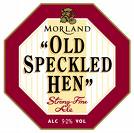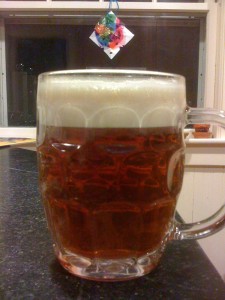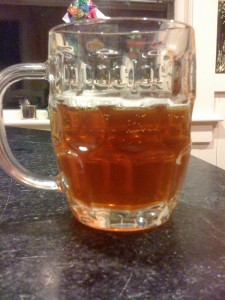Posted by British Brewer in
Recipes Online version with calculator can be found here.
Online version with calculator can be found here.
Next up in the series on Old Ales and Browns is another classic Old Ale available in both the UK and US, Old Speckled Hen, brewed by Greene King after its acquisition of the Morland Brewery in 2000. We have already covered the history of Greene King with the Abbot Ale recipe last year but Morland also has an interesting past.
Prior to its acquisition by Greene King, the Morland Brewery was located in Abingdon, now part of Oxfordshire, in the UK and has a history dating back to 1711. The original brewery was located in the town of West Ilsley started by a local farmer John Morland to brew stouts and porters, the popular ales of the time. Over the next 150 years the brewery slowly grew, remaining a family business, eventually acquiring 2 small breweries in nearby Abingdon in 1860. By 1880 Morland had moved its operations from West Ilsley to Abingdon and by 1885 they incorporated as a limited company registered as United Breweries. From this point on the company grew rapidly, buying out a number of local breweries. The company went public in 1994 and was acquired by Greene King in 2000. Throughout its history the company had a reputation for respecting the breweries they acquired, maintaining the original brewery names and brews. Post Greene King acquisition though only the Morland name survived, the Abingdon brewery did not and all production is now in the Greene King brewery based in Bury St. Edmunds in Suffolk, UK.
The history of Old Speckled is not so old but is definitely one worth noting. I found this description on wikipedia:
Old Speckled Hen was first brewed by Morlands of Abingdon in 1979. MG cars celebrated the 50th anniversary of their move to Abingdon, from Edmund Road in Cowley. They asked Morland to brew a special commemorative beer for the occasion, for which they would suggest the name and they would design the bottle label. The name chosen was Old Speckled Hen which took its name from a car which was brought to Abingdon, when the factory moved.
The car was called the MG Featherweight Fabric Saloon made from cellulosed fabric stretched over a wooden frame and was black speckled with gold. It became the factory’s demonstration model and general runabout and as it chugged about the factory people would say “There guz the Owd Speckl’d un”.
The original beer label bore the MG colours of cream and brown. The bottle dressing was finished with a green foil capsule, which matched the background colour of the Borough of Abingdon Arms. The beer was an amber colour and was brewed at a gravity of 1050 to denote 50 years (i.e. 1929 – 1979) of production of MG cars in Abingdon.
According the company website the ale is described as:
“Old Speckled Hen” has a full, smooth flavour and is very easy to drink. Its rich amber colour and superb fruity aromas are complemented by a delicious blend of malty tastes.
Toffee and malt combine with bitterness on the back of the tongue to give a balanced sweetness. This is followed by a refreshingly dry finish.
I can attest to the validity of the above notes for the pre-1999 version. In my experience the current export version is not as balanced or as rich and comes across a little dialed down in the flavour department. Not to worry though as is what this blog is about, trying to recreate the original and sample the ale fresh as John Morland intended.
The company website gives nothing away around ingredients, colour, or bitterness. It states the ale comes in 2 varieties, a cask version at 4.5% ABV and a bottled version at 5.2%. We will focus on the bottled. I consulted with the The Real Ale Almanac (5th edition, last published in 1999, so prior to the Greene King acquisition. Important to note considering many experts on this beer claim the recipe was changed) and it confirms the bottle strength is 5.2% ABV, with an OG of 1050 (a given considering the history of the ale), uses Pipkin Pale Malt as a base, Crystal Malt, brewers sugar, Challenger hops for bitterness, Goldings and Challenger for aroma with a range of 30-35 IBUs of bitterness.
Here are the tasting notes from the Almanac:
Nose: Superb Goldings hop aroma (considering using Goldings for a flavour addition at the end of the boil)
Palate: Full hops and fruit in mouth, long dry finish with hops and delicate fruit notes
Comments: Rich coloured and fruit flavoured strong ale with generous hop support.
(my italics) The only hint we have for colour is it is “Rich” and “Amber” (from the company website). My own experience put the colour as a light amber almost a dark golden colour. Given we have the OG and final ABV, bitterness and fermentables I believe the colour is a variable that will resolve itself. For yeast I will go with Wyeast #1275 Thames Valley Ale, its high attenuation will give the dry finish and both yeast and ale hail from the same location. So lets get busy and input the ingredients into the beer calculus system on hopville.com and balance the quantities in order to create a workable recipe conforming as best we can to the constraints above.
Morland Old Speckled Hen (BJCP Beer Style: Strong Ale, category: Old Ale)
- 2.5 Gallon, 60 min boil
- OG 1050, FG 1011
- 5.2% ABV
- 35 IBU
- 10° SRM (Gold to Copper)
- Ready to drink in 2+ Months
Base Malt and Fermentables:
- 2 lb 4 oz Light Dry Malt Extract (60 mins)
- 4 oz Cane Sugar (0 mins)
Specialty Grains:
Hops
- Bittering Hops – 0.5 oz Challenger (60 mins)
- Flavour Hop – 0.125 oz Challenger, 0.125 oz Goldings, East Kent (15 mins)
- Aroma Hop – 0.5 oz Goldings, East Kent (0 mins)
Yeast
- Wyeast Thames Valley Ale (1275)
Other Additions
- 1 tsp Irish Moss (15 mins)
- 1/4 tsp Yeast Nutrient (10 mins)
Process
- Please follow the process guidelines outlined in my post here. You will require all the equipment specified here.
- Primary Fermentation: 7 days at 65-75°
- Secondary Fermentation: 2 weeks in the same location as the primary
- Prime and store in the bottle for at least 4 weeks before consuming
- Peak flavour will be reached after 4 weeks in the bottle
 We really are on a run here. I have had numerous comments and emails on this blog and Hopville asking for feedback on my Old Speckled Hen clone. Well I am happy to report we nailed it. There is really nothing I would change. It has become a very popular ale in my house and I really wish I had brewed the whole 5 gallons and not limited myself to a 2.5 gallon test batch.
We really are on a run here. I have had numerous comments and emails on this blog and Hopville asking for feedback on my Old Speckled Hen clone. Well I am happy to report we nailed it. There is really nothing I would change. It has become a very popular ale in my house and I really wish I had brewed the whole 5 gallons and not limited myself to a 2.5 gallon test batch.
